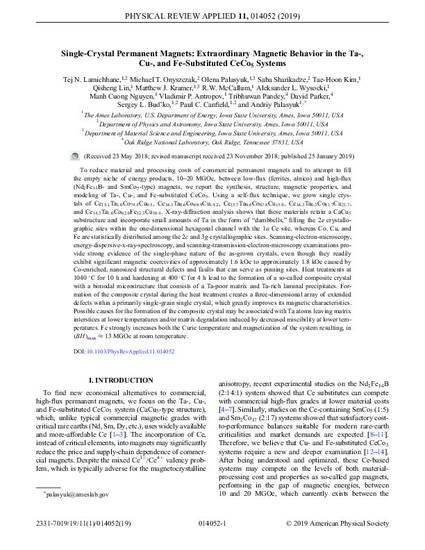
To reduce material and processing costs of commercial permanent magnets and to attempt to fill the empty niche of energy products, 10–20 MGOe, between low-flux (ferrites, alnico) and high-flux (Nd2Fe14B- and SmCo5-type) magnets, we report the synthesis, structure, magnetic properties, and modeling of Ta-, Cu-, and Fe-substituted CeCo5. Using a self-flux technique, we grow single crystals of Ce15.1Ta1.0Co74.4Cu9.5, Ce16.3Ta0.6Co68.9Cu14.2, Ce15.7Ta0.6Co67.8Cu15.9, Ce16.3Ta0.3Co61.7Cu21.7, and Ce14.3Ta1.0Co62.0Fe12.3Cu10.4. X-ray-diffraction analysis shows that these materials retain a CaCu5 substructure and incorporate small amounts of Ta in the form of “dumbbells,” filling the 2e crystallographic sites within the one-dimensional hexagonal channel with the 1a Ce site, whereas Co, Cu, and Fe are statistically distributed among the 2c and 3g crystallographic sites. Scanning-electron-microscopy, energy-dispersive-x-ray-spectroscopy, and scanning-transmission-electron-microscopy examinations provide strong evidence of the single-phase nature of the as-grown crystals, even though they readily exhibit significant magnetic coercivities of approximately 1.6 kOe to approximately 1.8 kOe caused by Co-enriched, nanosized structural defects and faults that can serve as pinning sites. Heat treatments at 1040∘C for 10 h and hardening at 400∘Cfor 4 h lead to the formation of a so-called composite crystal with a bimodal microstructure that consists of a Ta-poor matrix and Ta-rich laminal precipitates. Formation of the composite crystal during the heat treatment creates a three-dimensional array of extended defects within a primarily single-grain single crystal, which greatly improves its magnetic characteristics. Possible causes for the formation of the composite crystal may be associated with Ta atoms leaving matrix interstices at lower temperatures and/or matrix degradation induced by decreased miscibility at lower temperatures. Fe strongly increases both the Curie temperature and magnetization of the system resulting, in (BH)max≈13MGOe at room temperature.
Available at: http://works.bepress.com/paul_canfield/179/
